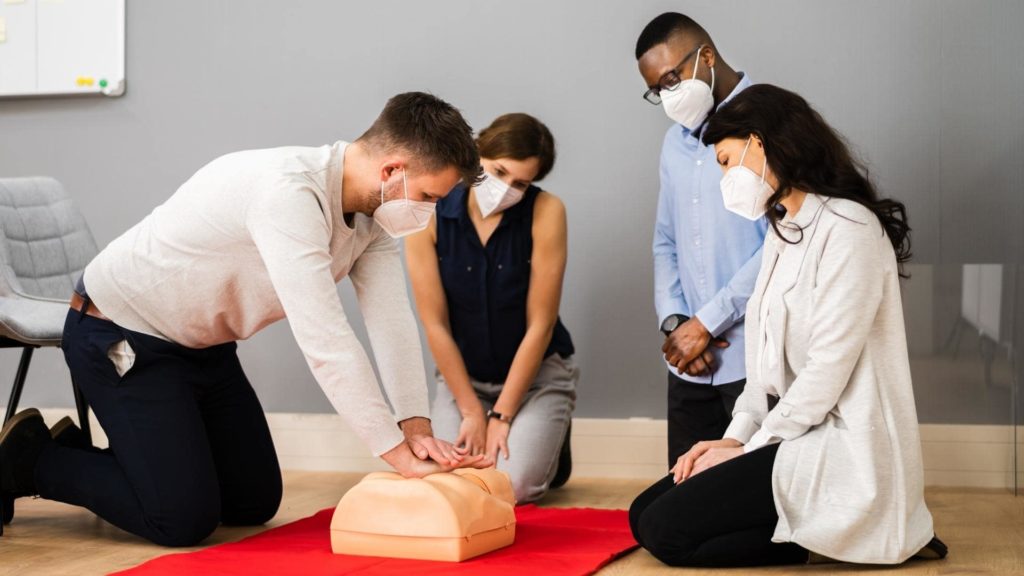First aid and CPR are both procedures administered in emergencies to help save lives. The difference between first aid and CPR is that first aid covers a broad spectrum of life-saving skills, including CPR. On the other hand, CPR training primarily focuses on how to perform CPR, use an AED and more to resuscitate unconscious victims that have no pulse.
What Is the Difference Between First Aid Training And CPR?
Both CPR and first aid are essential procedures that can help save lives. You can take a CPR class without first aid, but a first aid course through the Canadian Red Cross always includes CPR.
First Aid Training
During first aid training, you will learn a wide variety of procedures needed to help someone who is feeling ill or has suffered trauma from an accident. These procedures include treating deep cuts, burns, stopping bleeding, choking, allergic reactions, how to put a splint on a fractured bone, etc. You are trained to offer assistance to victims by relieving their pain and preventing them from suffering further injuries until professional medical assistance arrives.

CPR Training
During cardiopulmonary resuscitation (CPR) training, you are taught how to focus on someone who is experiencing cardiac arrest. Cardiac arrest is caused by sudden heart dysfunction. Any person suffering the condition will be unconscious and not able to breathe. CPR is also a form of first aid but applies only to cardiac arrest.
CPR is the only treatment that can help a victim of cardiac arrest because their heart has already stopped beating, and their condition is critical. The faster CPR is administered, the better the chance of the person’s revival and survival. Once revived, the person must be taken to a medical specialist immediately for further assessment of their condition and the cause.
A patient suffering from cardiac arrest cannot breathe. Therefore, the oxygen supply needed by the body is cut off. Since cells within the body rely on oxygen within the blood, damage starts taking place immediately when it is suddenly cut off. CPR training teaches you how to provide artificial heartbeat and restore blood circulation (also with the help of an AED), helping prevent damage to other vital organs. CPR training teaches you how to monitor the patient’s pulse and the importance of performing CPR until professional responders arrive.
CPR is Based on Specific Procedures
CPR training teaches you the correct procedures that must be carried out when helping a person suffering from cardiac arrest. During the training course, you are taught how each step follows the other and how to administer CPR without injuring the patient. Students will also learn how to use an Automated External Defibrillator (AED), a specific tool used on victims of cardiac arrest.
Inquire about CPR Training
Do you have questions regarding CPR training? Contact us today! Our customer service representatives are ready to assist you.
Is BLS The Same as CPR And First Aid?
There are several levels of CPR training. Namely, CPR A, CPR C, and CPR BLS. If you are unsure which level is the right one for you, here is a short explanation of each. Of course, before deciding, you should know that if you are getting CPR training for your job, you must choose the level that meets the requirements.

Basic Life Support (BLS)
Basic life support (BLS) is the level required if you are planning to become a professional first responder, paramedic, firefighter, or healthcare provider (doctor or nurse). Up until early 2019, the Canadian Red Cross taught the HCP (Health Care Provider) level of CPR, but then it was replaced with BLS.
The training only takes a few hours, and certification is valid for one year.
CPR C Training
CPR C training is very popular because it includes techniques to assist choking/unconscious adults, children, and infants. During the training, you are also taught how to apply two-rescuer CPR and use an AED. The training is required for all people working with children, those working in healthcare, and for most workplaces. Recertification is required every three years.
CPR A Training
Some workplaces just require CPR A training. During CPR A training you learn to assist adults who are choking or require CPR.
Is It Better to Take A CPR And First Aid Training Online or In-Person?
Online courses are very good if you want to learn the basics of first aid and CPR but don’t want to commute and want to complete it at your own pace. However, an all-in class or blended course is often the better option if you are learning first aid and CPR for your workplace or care for children and the elderly. By attending training, you get to practice everything you learn, especially the use of the equipment. This not only enhances your skills but gives you the added confidence to practice everything you learned during the course.

The Online Only training does not provide you with a WSIB approved certificate, but an all-in-class or online blended training does.
Make sure that the course you use is offered by an accredited training agency with high standards and highly qualified Canadian Red Cross instructors. Find a training facility near you!
Register to Earn CPR Certification!
Find which CPR certification is best for you!
Register for our first aid courses, you are one click away.




















No comment yet, add your voice below!